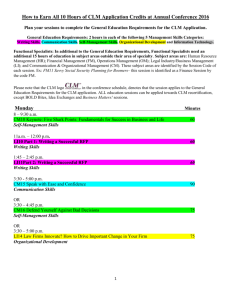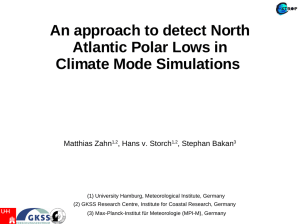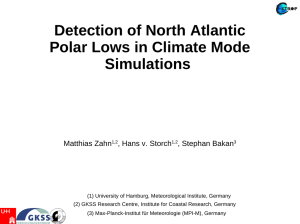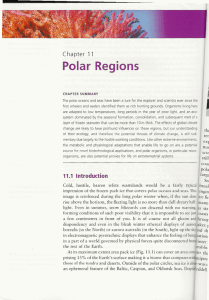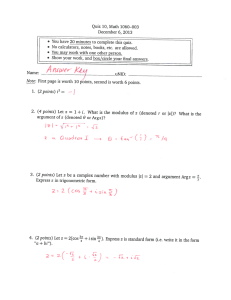Climate mode simulation of North Atlantic Polar Lows in a limited area model Matthias Zahn
advertisement
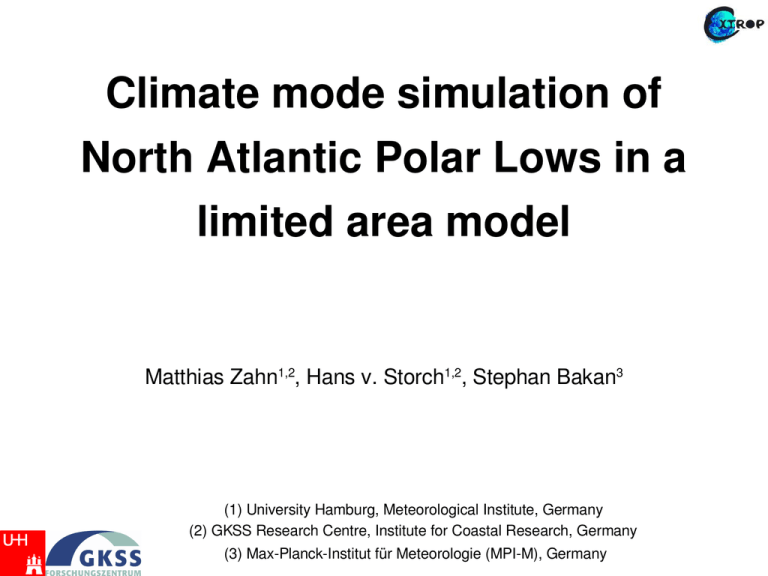
Climate mode simulation of North Atlantic Polar Lows in a limited area model Matthias Zahn1,2, Hans v. Storch1,2, Stephan Bakan3 (1) University Hamburg, Meteorological Institute, Germany (2) GKSS Research Centre, Institute for Coastal Research, Germany (3) Max­Planck­Institut für Meteorologie (MPI­M), Germany • Polar Lows/ Background • Polar Lows in LAMs • Data • Results • Conclusions • Example for application Polar Lows ● ● ● ● ● ● Polar Lows intense maritime mesoscale cyclones typically several hundred kilometers in diameter occurring poleward the Polar Front, October - March strong winds (>13,9m/s), severe weather, heavy precipitation develop extremely rapidly (reaching peak intensity within 24 hours) Arctic Hurricanes Rasmussen and Turner, 2003: Polar Lows: Mesoscale Weather Systems in the Polar Regions Nordeng, T., and E. Rasmussen, A most beautiful polar low. A case study of a polar low development in the bear island region., Tellus, 44A, 81–99, 1991 Polar Lows Polar Low development ● ● ● ● instable atmospheric conditions: baroclinic instability (shallow baroclinic zones) (CISK) conditional instability of second kind air-sea interaction instability (barotropic instability) form under cold upper level lows when cold arctic air flows over a warm body of water (delta T > 35 °C) cold air outbreaks triggered by convection/sensible heat flux http://meted.ucar.edu/norlat/snow/polarlows/, Rasmussen and Turner, 2003: Polar Lows: Mesoscale Weather Systems in the Polar Regions Background My thesis: Trends and variability in extratropical mesoscale cyclones (VI EXTROP): Long term aim: climatological description of polar low occurrences (features) EXTROP, http://www.extrop.zmaw.de/ Background • Comprehensive measurements are required to address such a question (long in time, high in spatial detail, homogeneous) • Use of numerical models in combination with existing measurements to reconstruct the past state of the atmosphere • First part: capability of LAM's to reproduce polar lows • Second part: detect polar lows • (Third part: derive climatology) PLows in CLM­data Ensemble simulations (2x4) with CLM ( ~50km ) in climate mode for polar low cases Oct. 1993 (and Dec.1993, Jan. 1998) • Driven by the NCEP reanalysis • Initial times (approx. two weeks prior to polar low formation) • Spectral Nudging (4x) and without (4x) • Different waves (above appr. 700 km) Hans von Storch, Heike Langenberg, and Frauke Feser, A Spectral Nudging Technique for Dynamical Downscaling Purposes, Monthly Weather Review 128(10) 3664­3673. http://clm.gkss.de/ PLows in CLM­data Nielsens (1997) case, Oct. 1993 synoptic scale low, “the Swan”, shallow baroclinic processes combined with upper level vorticity advection Nielsen,1997: An early Autumn polar low formation over the Norwegian Sea, J.Geophys. Res., 102, 13955­13973 PLows in CLM­data Nielsens (1997) case, Oct. 1993 Mature state polar low: reaching peak intensity, wind speeds above gale force, closed small scale surface low Nielsen,1997: An early Autumn polar low formation over the Norwegian Sea, J.Geophys. Res., 102, 13955­13973 PLows in CLM­data Nielsens (1997) case, Oct. 1993 decaying quickly after landfall Nielsen,1997: An early Autumn polar low formation over the Norwegian Sea, J.Geophys. Res., 102, 13955­13973 PLows in CLM­results 15.10., 6:00 NCEP DWD 10m wind speed ≥ 13.9m/s and air pressure (at mean sea level) on 15. October 1993: NCEP/NCAR analysis after interpolation onto the CLM grid, 6:00 UTC, DWD analysis data, 6:00 UTC, CLM ensemble run without (nn) and with(sn) spectral nudging , 9:00 UTC PLows in CLM­results 15.10., 6:00 NCEP CLM01­nn CLM02­nn DWD CLM03­nn 10m wind speed ≥ 13.9m/s and air pressure (at mean sea level) on 15. October 1993: NCEP/NCAR analysis after interpolation onto the CLM grid, 6:00 UTC, DWD analysis data, 6:00 UTC, CLM ensemble run without (nn) and with(sn) spectral nudging , 9:00 UTC CLM04­nn PLows in CLM­results 15.10., 6:00 NCEP DWD CLM01­nn CLM02­nn CLM03­nn CLM04­nn CLM01­sn CLM02­sn CLM03­sn CLM04­sn 10m wind speed ≥ 13.9m/s and air pressure (at mean sea level) on 15. October 1993: NCEP/NCAR analysis after interpolation onto the CLM grid, 6:00 UTC, DWD analysis data, 6:00 UTC, CLM ensemble run without (nn) and with(sn) spectral nudging , 9:00 UTC PLows in CLM­results Track of polar low's local sea level pressure minimum in CLM­sn CLM01­sn CLM02­sn CLM03­sn Start: 14.10 15:00 until 18.10. 0:00 CLM04­sn PLows in CLM­results Pattern correlation coefficients (PCC) between HOAPS(b) and CLM(a) 1993 Oct solid: sn , dashed: nn P a b = ∑i ai −a bi −b ∑i a i− a2 ∑i b˙i −b2 1998 Jan 1993 Dec HOAPS, Hamburg Ocean Atmosphere Parameters and Fluxes from Satellite Data, http://www.hoaps.zmaw.de/ PLows in CLM­results Concept of scale separation to cut off mesoscale features Response function ­ corresponding to wave lengths from ~200 km – ~600 km Feser, F., and H. von Storch, A spatial two­dimensional discrete filter for limited area model evaluation purposes, Mon. Wea. Rev., 133(6), 1774–1786, 2005 PLows in CLM­results 15.10., 6:00 NCEP DWD CLM01­nn CLM02­nn CLM03­nn CLM04­nn CLM01­sn CLM02­sn CLM03­sn CLM04­sn Band­pass filtered mslp (isolines; hPa) and 10m wind speed anomalies, NCEP/NCAR analysis after interpolation onto the CLM grid, 6:00 UTC, DWD analysis data, 6:00 UTC, CLM ensemble run without and with spectral nudging, 9:00 UTC. Black dots indicate the positions of the polar lows pressure minimum in the respective untreated field of the ensemble run. PLows in CLM­results The 1993 case: Weather chart, DWD, 9.12.1993, 0:00 CLM22­sn, filtered CLM22­sn, untreated Rasmussen and Turner, 2003: Polar Lows: Mesoscale Weather Systems in the Polar Regions PLows in CLM­results The 1998 case: Weather chart, 18.1.1998, 1:00 CLM01­sn, filtered, at 0:00 CLM01­sn, untreated, 0:00 Woetmann Nielsen, N., Om forudsigelighed af polare lavtryk, Vejret, 20, 37–48, in Danish, 1998 PLows in CLM­results CAPE in these Cases: 1993, Oct 1998, Jan 1993, Dec PLows in CLM­conclusion CONCLUSION: • Principally, Polar Lows can be reproduced with CLM run in climate mode • Though, there may be deviations in location and amount of pressure minima • A digital filter could be useful for an automatic detection Application Application of Results (preliminary): Detection algorithm, criteria: strong minimum, or: 1. minimum in filtered MSLP field 2. surrounding wind speed above 13.9 m/s 3. no synoptic low 4. also local minimum in untreated MSLP field 5. surrounding CAPE above 100 J/kg and detected at least twice Application Detected features according to these criteria Simulation period: October 1993 until September 1995 Winters (ONDJFM) Summers (AMJJAS) Application Jan. 2002 Red dots: Norwegian Meteorological Service, green dots: detected Application ? 4.1.02, 4:00 5.1.02, 15:00 Application 29.1.02, 5:00 29.1.02, 15:00 Application 30.1.02, 4:00 31.1.02, 14:00 Outlook Outlook / future plans • More cases (differentiation of dynamical development/ forcing mechanisms/ size/ other parameters) • [...] • Simulation over 50 years • Climatology Thank you very much

